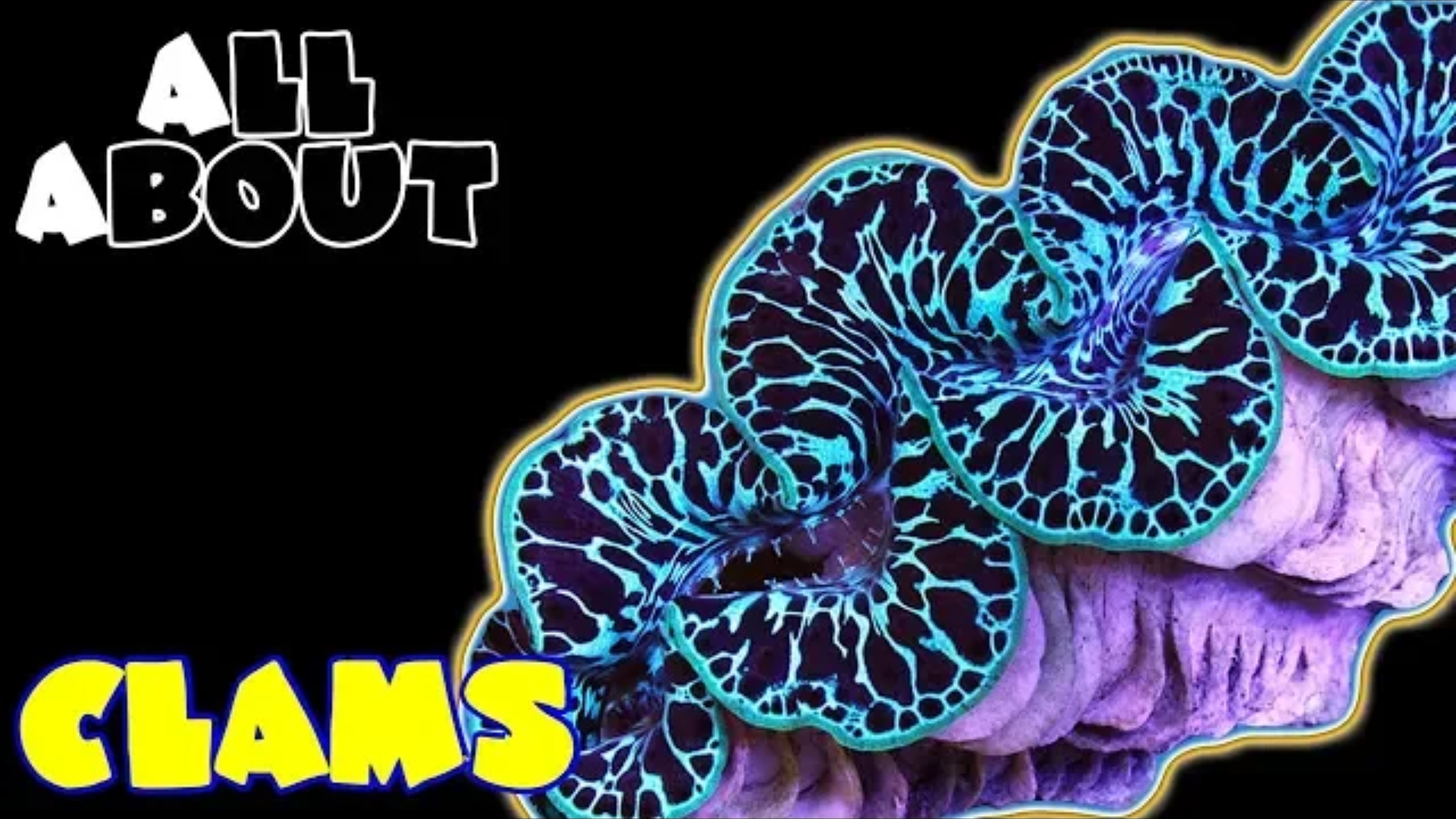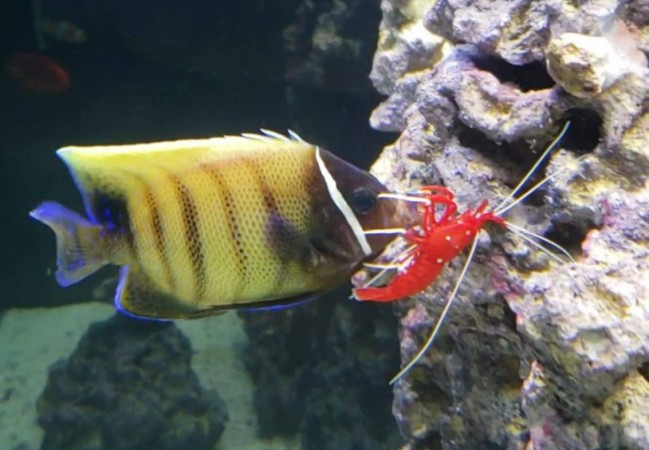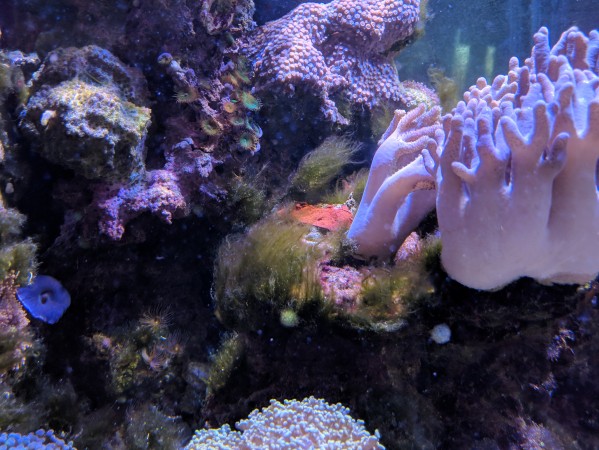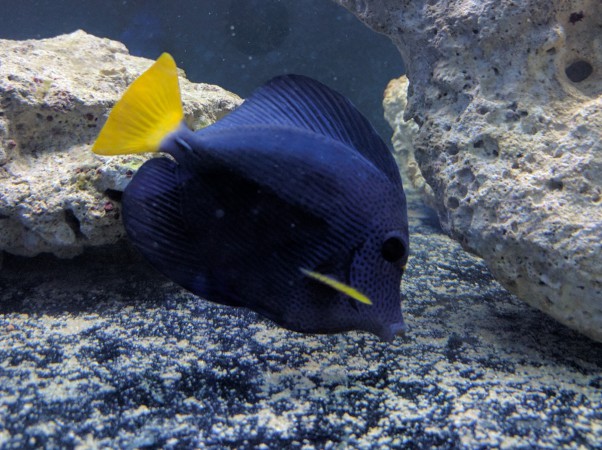- Name:
Crocea Clam, Ultra
- Family: Tridacnidae
- Species: Clam
- Scientific Name: Tridacna crocea
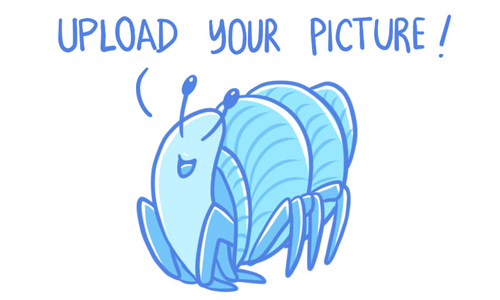
General info about Crocea Clam, Ultra
The family Tridacnidae contains a number of clams that are common in the aquarium trade. Collectively, they are commonly called “Tridacna Clams” by hobbyists. These animals are beautiful, interesting, and highly variable, with no two clams looking alike. Their colorful mantles contain photosynthetic zooxanthellae, similar to corals. Although very beautiful, clams are not for everyone. However, if you are already a successful reef hobbyist with an established, stable system and high water quality, you probably already have the skills to keep a clam in your aquarium.
The Crocea Clam is most known and the smallest of the “Giant Clam” family, only growing to 5 or 6 inches in the captivity, which makes them great reef tank inhabitants. As mentioned earlier, this species is beautiful but difficult to care for, so it is not suggested for a beginning aquarist. Both the Crocea Clam and the Ultra Clam are fairly tolerant of strong water motion and relatively strong fluctuations in water parameters than some of the other Tridacna clams. However, most have a poor record for long-term survival so they are recommended for the intermediate to advanced aquarists.
The beauty of its mantle with its rich variety of patterns and vivid colorations makes for a spectacular display in reef aquariums that are illuminated properly. They are known to live together in great congregations, and they can attain a maximum size of 12 inches in the wild. The vast majority of them available in the aquarium trade are cultured on land-based clam farms in the Central and South Pacific. Crocea Clams are found in an endless variety of colors and patterns, and these clams are graded for size, their intensity of coloration, and how complex their patterns are, and then priced accordingly. Larger clams that have the most intense coloration and intricate patterns are much more expensive.
Ultra Clams can be identified by having a more elongated shell that lacks symmetry, with narrowly spaced scutes or scallops on the upper portions of each side of their hinged shells. Like some other members of its genus, Ultra clam attach to hard substrate or rockwork with the thread like appendages called byssal filaments, and can eventually burrow or bore into porous substrate over time. They will arrive either unattached or attached to a small piece of rock or substrate. They will normally attach to a solid surface within a day or so of being introduced into the aquarium, so keep in mind that their first placement should be considered permanent. Never forcibly remove an attached clam from the substrate or rockwork, as lethal damage to their foot and other tissue will be inevitable. As a last resort, to remove a clam from a hard surface gently cut each byssal thread with a razor blade as close to the attachment point of the rock or solid surface, making sure not to slice or damage any tissue.
In the home aquarium, the Ultra Clams require intense lighting to thrive as they contain the symbiotic algae called zooxanthellae and receive the majority of their nutrition from the light through photosynthesis. Smaller clams that are 2 inches or less in size are much more sensitive to very intense lighting as their membrane is much thinner than larger specimens. For this reason, care should be taken to properly photo-adapt them to the existing reef aquarium lighting in a similar manner to newly introduced stony and soft corals. When adapting a new Ultra Clam to very intense lighting, it is ideal to set them on a small rock or in a plastic dish with coarse substrate at the bottom of the aquarium. Over time the clam can then be slowly moved up higher in the aquarium.
They are relatively hardy clams and require intense lighting and good water flow in the home aquarium. Since the majority of the clam species kept in the aquarium come from relatively shallow areas of the reef, they are accustomed to intense light, which is what they should receive in the aquarium. High light intensity is very important. It’s very difficult to over-light clams. Proper water chemistry is very important, and they will thrive when calcium levels of 380- 450 mg/L, an alkalinity level of 8-11 dKH, and a magnesium level of 1280-1350 ppm are maintained. Be careful to adjust magnesium levels before checking calcium levels.
They require stable environmental conditions and excellent water quality. Clams should be placed in an area of the aquarium where they can receive appropriate water movement and lighting. Ideally, water movement should be more or less random, surging flow-enough to keep things moving, yet not so strong as to make the clam’s mantle fold over on itself, or force the clam to withdraw its mantle on a continuous basis. In our experience, it’s best to place clams on a hard substrate, upon which they can attach tough fibers, known as the byssus, to secure themselves in place.
Stable tank conditions are required to keep the Crocea Clams healthy. Do typical water changes of 20% a month, 10% biweekly, or 5% weekly. It has been noted that 5% weekly water changes replenish many of the needed additives. Crocea Clams can handle strong water motion and relatively strong fluctuations in water parameters, but you really don't want your water parameters to fluctuate too much.
Clams have few natural predators. However, in the aquarium, the excessive incidental picking activities of fishes like Angelfishes, Butterflyfishes, Tangs, Triggerfishes, and even Gobies and Blennies can irritate clams to the point where they no longer extend their mantles. In addition, there are certain snails, such as Pyramidellidae, which sometimes plague clams. Small pyramidellid snails that bore into their tissue and feed on their bodily fluids. While this is less of a problem in the wild, it is more of an issue in the tank. Fortunately, there are several regularly available wrasses that prey on these snails, such as Halichoeres melanurus, Halichoeres argus, and Halichoeres chloropterus.
When obtaining a captive grown clam, getting a specimen that is at least 2 inches, ideally 4 inches, is best. Smaller specimens do not ship well nor do they adapt as easily. If obtaining a clam from the wild, you will have a much better chance of success if you receive it still attached to a rock. When a healthy Crocea Clam is obtained, with careful handling and proper lighting it will establish itself. When first obtained, inspect the clam's shell for predators. It is important to make sure they are not being irritated or fed upon by other organisms. They are sensitive to being handled, so avoid that as much as possible.
A clam that is predominately brown and showing little of its normal coloration and patterning, should be placed lower in the tank away from strong lighting. The brown coloration is the clam's zooxanthellae showing and is probably due to the clam losing its protective coloration during shipping. While they will adjust to their new surroundings in time and become a little harder, but avoid wide fluctuations in light, water flow, reef water parameters (calcium, magnesium, etc.), and salinity.
Crocea Clams are sensitive to being handled so avoid it if at all possible. Because these clams burrow into rock and rely heavily on their byssal threads for attachment, they will eventually bore into a substrate or other substance on which they are placed. Damage could be done when messing around with an attached clam.
Crocea Clam, Ultra Diet & Nutrition
Most clams fulfill their nutritional requirements by filter feeding and absorbing dissolved organic compounds from the water. The Tridacna clams have gone even further than this, using zooxanthellae to manufacture food for themselves. They receive the majority of their nutrition from their zooxanthellae. Yet research has shown that all Giant Clams that are under 4 inches do not have enough mantle tissue to provide enough space for zooxanthellae to keep the clam alive. Clams under 2 inches to 4 inches need regular feedings of phytoplankton or green water supplement several times per week if maintained in a nutrient-poor reef aquarium. If provided with sufficient lighting intensity, no supplemental feeding is required for more than 4 inches. The zooxanthella provides the bulk of the nutrition that clams require, with dissolved nutrients in the aquarium water, such as nitrate from fish waste, providing the rest.
If you wish to feed your clam, it is suggested that they are fed micro-foods designed for filter feeders, especially when small. A yeast-based suspension that has been mechanically whisked, live phytoplankton or commercially prepared micro-foods like 'marine snow' or 'reef snow' can be offered. This may not be as necessary if there is a healthy population of fish in the tank. As mentioned above, with plenty of fish present, direct feeding is not as critical once they are over 4 inches long. When there is a good fish population, most clams fulfill their nutritional requirements by filter feeding and absorbing dissolved organic compounds from the water. Larger clams, however, may still benefit from phytoplankton foods fed on a regular schedule in an aggressively skimmed tank.
Basic nutrients in the aquarium that clams need are calcium, strontium, iodine, and a minute amount of nitrate. Calcium at levels of at least 280 mg/L is necessary for growth to occur. More rapid, natural growth is seen when calcium is in the range of 400-480 mg/L. Strontium is incorporated in the shell along with calcium and should also be provided for optimum growth. The addition of iodine to the aquarium will also enhance growth and color. Use caution, as iodine spikes have been known to kill them. Add iodine with the top off water or dose daily, but not at one time in a big weekly dose. They require some nitrogen for proper growth. They will not thrive at a level of 0 nitrates. Nitrate can be added if levels are extremely low, but be careful as nitrates should never exceed 2 mg/L. Provide a minute amount of nitrate that is at least 2 ppm.
The frequency of feeding should be daily for clams up to 2 inches and several times per week for clams up to 4 inches is recommended. Can be fed weekly when full grown, but do not feed if there are plenty of fish in the tank.
Determining Sex of Crocea Clam, Ultra
There are no discernible sexual differences.
Breeding & Spawning Crocea Clam, Ultra
The giant clams are protandry, meaning they are born male and change to female. Clams will release eggs and sperm that can number into the tens of thousands of eggs. This event tends to happen around sunset. One aquarist noted a spawning clam pulsing out eggs every two minutes. Once the eggs are externally fertilized, the embryos develop into trochophore larva, which are free-swimming. The next stage is the bivalve veliger, which sort of looks like a tiny free-swimming clam. Once they are 4 to 20 mm long, they will start to burrow into the reef and begin their lives in their new home.
Crocea Clams have been propagated in captivity, and the demand from aquarists has raised interest in producing colorful varieties of all the species. Typically, there is some sort of outside stimuli that causes spawning, which can be a change in temperature, salinity, or other parameters. However, this should be left to the experts, as clams spawning in a small system can cause serious pollution issues.
Common Diseases with Crocea Clam, Ultra
Keep a watch out for predators! The Giant Clams can be easy prey with their large and wide byssal gland opening. The most dangerous predators are the highly prolific pyramidellid snails of the Tathrella, Pyrgiscus, and Turbonilla genera. These are parasitic snails about the size of a grain of rice or smaller, rarely reaching a maximum size of about 7mm in length. These snails attack tridacnids with a trunk-like snout called a "proboscis." They punch holes into the clam's soft tissue and then feed on its bodily fluids.
While in nature, giant clams can deal with a few of these parasitic snails, in captivity these snails tend to multiply to dangerous numbers. They may hide in the scutes of the clam or in the substrate by day, but will often be found around the edges of the clam's mantle tissue or byssal gape (large foot hole) after the lights go out. They can produce numerous small, gelatinous, egg masses on the clam's shell. These masses are transparent, so difficult to spot. Before putting it in the tank, scrub your clam's shell vigorously with a toothbrush, or other brush with firm bristles, to remove the snails and their eggs. Be careful not to scrub the clam's soft tissues, as that can cause injury and lead to infection. Inspect your clam regularly for several months and remove any snails you discover.
Crocea Clam, Ultra Origin
They are found in the Indo-West Pacific from the Andaman Islands to Fiji and then North to Japan and southward to New Caledonia and Queensland.
Original Detail
| Name | Species | Family | Scientific Name | More Detail | Added by |
|---|---|---|---|---|---|
| Crocea Clam, Ultra | Clam | Tridacnidae | Tridacna crocea | The family Tridacnidae contains a number of clams that are common in the aquarium trade. Collectively, they are commonly called “Tridacna Clams” by hobbyists. These animals are beautiful, interesting, and highly variable, with no two clams looking alike. Their colorful mantles contain photosynthetic zooxanthellae, similar to corals. Although very beautiful, clams are not for everyone. However, if you are already a successful reef hobbyist with an established, stable system and high water quality, you probably already have the skills to keep a clam in your aquarium. The Crocea Clam is most known and the smallest of the “Giant Clam” family, only growing to 5 or 6 inches in the captivity, which makes them great reef tank inhabitants. As mentioned earlier, this species is beautiful but difficult to care for, so it is not suggested for a beginning aquarist. Both the Crocea Clam and the Ultra Clam are fairly tolerant of strong water motion and relatively strong fluctuations in water parameters than some of the other Tridacna clams. However, most have a poor record for long-term survival so they are recommended for the intermediate to advanced aquarists. The beauty of its mantle with its rich variety of patterns and vivid colorations makes for a spectacular display in reef aquariums that are illuminated properly. They are known to live together in great congregations, and they can attain a maximum size of 12 inches in the wild. The vast majority of them available in the aquarium trade are cultured on land-based clam farms in the Central and South Pacific. Crocea Clams are found in an endless variety of colors and patterns, and these clams are graded for size, their intensity of coloration, and how complex their patterns are, and then priced accordingly. Larger clams that have the most intense coloration and intricate patterns are much more expensive. Ultra Clams can be identified by having a more elongated shell that lacks symmetry, with narrowly spaced scutes or scallops on the upper portions of each side of their hinged shells. Like some other members of its genus, Ultra clam attach to hard substrate or rockwork with the thread like appendages called byssal filaments, and can eventually burrow or bore into porous substrate over time. They will arrive either unattached or attached to a small piece of rock or substrate. They will normally attach to a solid surface within a day or so of being introduced into the aquarium, so keep in mind that their first placement should be considered permanent. Never forcibly remove an attached clam from the substrate or rockwork, as lethal damage to their foot and other tissue will be inevitable. As a last resort, to remove a clam from a hard surface gently cut each byssal thread with a razor blade as close to the attachment point of the rock or solid surface, making sure not to slice or damage any tissue. In the home aquarium, the Ultra Clams require intense lighting to thrive as they contain the symbiotic algae called zooxanthellae and receive the majority of their nutrition from the light through photosynthesis. Smaller clams that are 2 inches or less in size are much more sensitive to very intense lighting as their membrane is much thinner than larger specimens. For this reason, care should be taken to properly photo-adapt them to the existing reef aquarium lighting in a similar manner to newly introduced stony and soft corals. When adapting a new Ultra Clam to very intense lighting, it is ideal to set them on a small rock or in a plastic dish with coarse substrate at the bottom of the aquarium. Over time the clam can then be slowly moved up higher in the aquarium. They are relatively hardy clams and require intense lighting and good water flow in the home aquarium. Since the majority of the clam species kept in the aquarium come from relatively shallow areas of the reef, they are accustomed to intense light, which is what they should receive in the aquarium. High light intensity is very important. It’s very difficult to over-light clams. Proper water chemistry is very important, and they will thrive when calcium levels of 380- 450 mg/L, an alkalinity level of 8-11 dKH, and a magnesium level of 1280-1350 ppm are maintained. Be careful to adjust magnesium levels before checking calcium levels. They require stable environmental conditions and excellent water quality. Clams should be placed in an area of the aquarium where they can receive appropriate water movement and lighting. Ideally, water movement should be more or less random, surging flow-enough to keep things moving, yet not so strong as to make the clam’s mantle fold over on itself, or force the clam to withdraw its mantle on a continuous basis. In our experience, it’s best to place clams on a hard substrate, upon which they can attach tough fibers, known as the byssus, to secure themselves in place. Stable tank conditions are required to keep the Crocea Clams healthy. Do typical water changes of 20% a month, 10% biweekly, or 5% weekly. It has been noted that 5% weekly water changes replenish many of the needed additives. Crocea Clams can handle strong water motion and relatively strong fluctuations in water parameters, but you really don't want your water parameters to fluctuate too much. Clams have few natural predators. However, in the aquarium, the excessive incidental picking activities of fishes like Angelfishes, Butterflyfishes, Tangs, Triggerfishes, and even Gobies and Blennies can irritate clams to the point where they no longer extend their mantles. In addition, there are certain snails, such as Pyramidellidae, which sometimes plague clams. Small pyramidellid snails that bore into their tissue and feed on their bodily fluids. While this is less of a problem in the wild, it is more of an issue in the tank. Fortunately, there are several regularly available wrasses that prey on these snails, such as Halichoeres melanurus, Halichoeres argus, and Halichoeres chloropterus. When obtaining a captive grown clam, getting a specimen that is at least 2 inches, ideally 4 inches, is best. Smaller specimens do not ship well nor do they adapt as easily. If obtaining a clam from the wild, you will have a much better chance of success if you receive it still attached to a rock. When a healthy Crocea Clam is obtained, with careful handling and proper lighting it will establish itself. When first obtained, inspect the clam's shell for predators. It is important to make sure they are not being irritated or fed upon by other organisms. They are sensitive to being handled, so avoid that as much as possible. A clam that is predominately brown and showing little of its normal coloration and patterning, should be placed lower in the tank away from strong lighting. The brown coloration is the clam's zooxanthellae showing and is probably due to the clam losing its protective coloration during shipping. While they will adjust to their new surroundings in time and become a little harder, but avoid wide fluctuations in light, water flow, reef water parameters (calcium, magnesium, etc.), and salinity. Crocea Clams are sensitive to being handled so avoid it if at all possible. Because these clams burrow into rock and rely heavily on their byssal threads for attachment, they will eventually bore into a substrate or other substance on which they are placed. Damage could be done when messing around with an attached clam. |
Admin |
Changed by users
| Submitted Date | Submitted By | Status | Action |
|---|---|---|---|
| 2019-01-04 22:19:24 | merve kutsal | Approved | Edit |
| 2019-01-04 20:55:31 | merve kutsal | Approved | Edit |
| 2019-01-04 20:18:32 | merve kutsal | Approved | Edit |
| 2019-01-04 19:54:06 | merve kutsal | Approved | Edit |
| 2019-01-04 19:34:27 | merve kutsal | Approved | Edit |
| 2019-01-04 18:52:36 | merve kutsal | Approved | Edit |


